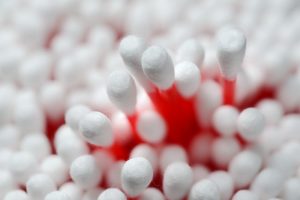Our ears are extremely delicate parts of our bodies, and even more so in children who are still developing. If you notice a build up of wax in your child’s ear, it’s important to understand the safest method to remove it. Many common home remedies can risk damage to the sensitive inner ear and can actually worsen symptoms.
Ear wax, or cerumen, is an important component in promoting good ear health.
For the most part it should be left untouched. It allows our ears to remain lubricated to avoid a dry and itchy sensation. It helps to prevent infection and traps dust, dirt and insects before they can venture too far into the ear.
An ear that is functioning healthily will naturally remove ear wax itself. But in some cases, this self-cleaning may function inefficiently. This may lead to wax build-up or potentially blocked ear wax impaction. It can be tempting to reach for the cotton tip at this point, but inserting any object into the ear should be avoided. In most cases, this may push wax deeper into the ear where it can become impacted. 1 in 10 children suffer from ear wax blockages. Young children may experience this as a result of poking their fingers into their ears and due to generally having more narrow canals.

Symptoms of a Blocked Ear
How can you determine what a ‘normal’ level of wax is?
Due to its important role in ear health, ear wax should only be removed when ear wax blockages are detected. Fortunately, there are some tell-tale signs that indicate your child could be suffering from a blocked ear. These include:
- Odour or discharge from the ear
- Pain
- Itching
- A cough
- Hearing loss
- A feeling of blockage or fullness
- Complaints of a ringing (tinnitus) ear
- Dizziness
If your child is old enough to talk, they can describe their symptoms to you. If your child is not yet capable of speaking, their discomfort will usually be shown through ear pulling or tugging, scratching at the ears, or an apparent loss of hearing. The excess deposits might even be visible in the outer ear.
Speech delays in children have also been linked to ear wax blockages.
Teaching kids how to identify symptoms of a blockage when they arise can prevent the condition from worsening.
Earwax Removal in Children
Home Treatment
We understand how difficult it is to see your child in pain or discomfort. However, attempting to stick anything into their delicate ears to clear the blocked ear wax may do more harm than good. This applies to cotton tips, tweezers, ear candles or any small object.
The use of ear wax softening drops can be effective to help reduce symptoms in children. They are applied into the ear to soften and disintegrate the impacted ear wax. Softening drops are available over the counter at chemists and are a useful first step in impacted ear wax removal. Once the cerumen has been sufficiently softened, it can be wiped away from the outer ear.
If this does not alleviate your child’s symptoms, the next step is to consult a medical professional. Earworx have a range of clinics across Australia specialising in safe and gentle earwax removal for children over four. During an appointment, one of our Registered Nurses will carefully inspect your child’s ear to determine if wax removal is required.
Micro Suction
If your nurse decides extraction is required, they will use a gentle method known as micro suction. This procedure is highly endorsed by ENT specialists for its safety and efficiency in removing impacted earwax. The process uses a micro suction catheter, similar to a mini vacuum, under binocular inspection to softly remove the ear wax. The entire consult typically takes under half an hour, allowing your child to bounce back quickly.
Micro suction is undoubtedly the best method of ear wax removal for both adults and children. Its precision makes it suitable for young ears, and even infected ears. If you have any concerns going into the process, our friendly nurses can happily answer any questions or queries.
How to Prevent Blocked Ears
Some children are simply more prone to excess cerumen production as a result of genetics. There are some preventive measures you can take to prevent blockages from occurring.
If you find blockages are becoming a constant occurrence, we suggest using softening drops routinely to help regulate the natural removal process. Begin with once a month and adjust accordingly or as per medical advice. A regular annual consult with an Earworx professional will help promote good aural hygiene. If your child has an ear drum perforation, do not use drops and consult a professional for ear wax removal.
Education plays a large part in ear health. Teach your children the importance of never sticking anything inside their ear to avoid developing impacted ear wax. Our nurses can gladly provide tips on ear health, so don’t be afraid to ask them at your next session! Book your next consult today.




